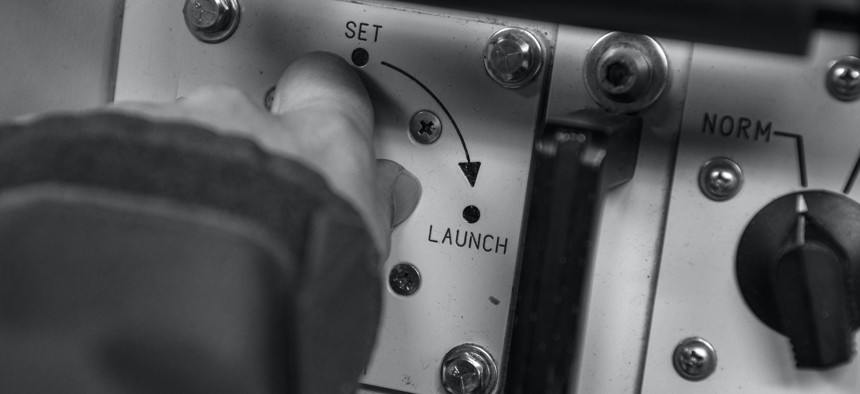
First Lt. Paul Lee, 321st Missile Squadron missile combat crew commander, prepares to perform a simulated key turn of the Minuteman III weapon system during a Simulated Electronic Launch-Minuteman test inside the launch control center at a missile alert facility in the 90th Missile Wing's missile complex, Neb., April 11, 2017. U.S. Air Force / Staff Sgt. Christopher Ruano
Who’s Afraid of an ICBM Review?
It’s worth spending five figures to assess whether to move ahead with a program that could cost more than a quarter-trillion dollars.
The Pentagon’s grant of $75,000 to the Carnegie Endowment for International Peace for a study of options for the land-based leg of the nuclear triad has prompted howls of protest from boosters of the Pentagon’s plan to build a new ICBM, known formally as the Ground-Based Nuclear Deterrent, or GBSD. Sen. James Inhofe, R-Okla., and Rep. Mike Rogers, R-Ala., ranking Republicans on the Senate and House armed services committees, have argued that the issue has already been well studied, and that the Carnegie effort should be canceled.
Why the uproar? Isn’t it worth spending $75,000 to assess whether to go ahead with a program that could cost $264 billion over its lifetime, including $110 billion for development and procurement? The outrage expressed by Inhofe and Rogers suggests that the fear the outcome of an assessment that might involve questioning the need for a new ICBM or proposing a significant change in DoD plans for the system. As James Acton, who is working on the Carnegie study, has noted, it will “identify the benefits, risks and unanswered questions associated with a number of alternatives.” This seems like common sense before locking the Pentagon into building a new ICBM that could last through 2075, at a phenomenal cost to U.S. taxpayers.
If anything, the Carnegie study should just be one element of a larger effort to determine whether a new ICBM is actually needed. Senate Armed Services Committee member Sen. Elizabeth Warren, D-Mass., has called for a technical and budgetary assessment of the potential for refurbishing and extending the useful life of the current fleet of Minuteman III ICBMs as an alternative to building the GBSD. A 2020 report by the Union of Concerned Scientists noted that a number of past assessments, including ones by the Air Force, the RAND Corporation, and the Congressional Budget Office, have suggested that current ICBMs could be extended through at least 2045 for tens of billions of dollars less than the cost of building a new ICBM. The Air Force and the RAND corporation have since contradicted these earlier findings, but their new assertions appear to be based on questionable assumptions about when the decision point for building a new ICBM versus sticking with existing missiles should be. A recent RAND report that in part addresses the question of whether to modernize existing ICBMs or build a new one largely reiterates the Air Force’s own arguments. Hence the need for a new, independent assessment, as called for by Sen. Warren.
The larger question looming over this whole debate is whether ICBMs are needed at all. The current U.S. force of nuclear-armed bombers and hard-to-detect ballistic missile submarines is more than sufficient to deter any country from attacking the United States, and many analysts have concluded that keeping ICBMs in the force is far riskier than getting rid of them. As former Defense Secretary William Perry has noted, ICBMs are “some of the most dangerous weapons in the world” because the president would have only a matter of minutes to decide whether to launch them in a crisis, greatly increasing the risk of an accidental nuclear war based on a false alarm.
So why are we poised to invest hundreds of billions of dollars in a new ICBM? In part, the drive for the GBSD is based on outmoded thinking that treats the triad of nuclear-armed bombers, submarines, and land-based missiles as sacrosanct regardless of the current realities of the global nuclear balance. But another powerful reason for moving full speed ahead on a new ICBM is pork-barrel politics: the money that will flow to key contractors like Northrop Grumman and key states like Montana, Wyoming, Utah, North Dakota, and California for building and providing bases for the new system. The Senate even has an “ICBM Coalition” comprised of senators from four of the five key states noted above that has been remarkably successful over the years in blocking any changes in ICBM spending or deployment. And the top dozen contractors involved in the ICBM program have lavished millions of dollars in campaign contributions on key members of Congress to reinforce their case for building the new system, including hundreds of thousands to advocates like Sen. Inhofe and Rep. Rogers. Campaign dollars don’t always lead to decisions directly benefitting the donor, but they ensure access that makes it far easier to state their case.
As we approach the date for the release of the Biden team’s Nuclear Posture Review, one can only hope that the administration remains open to new thinking on the future of the ICBM force. Our long-term security depends on it.
William D. Hartung is a senior research fellow at the Quincy Institute for Responsible Statecraft and the author of "Prophets of War: Lockheed Martin and the Making of the Military Industrial Complex." Before joining the Quincy Institute, he was the director of the Arms and Security Program at the Center for International Policy and a co-director of the Center's Sustainable Defense Task Force.



